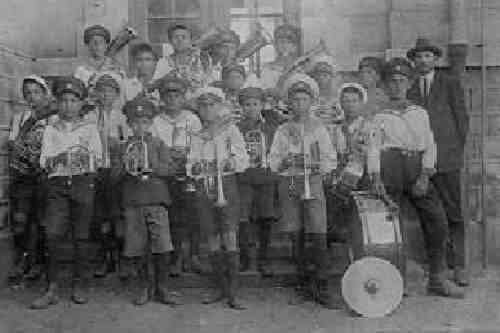
Figure 1.--This photograph at a Bulgarian school was taken in the early 1920s. HBC is unsure if the boys wear a sailor suit school uniform or more likely a band uniform. |

|
We have little information on Bulgarian schools and education at this time. Bulgaria was the last of the Christian Balkan people to throw off Ottoman rule. The public school system that was after undependence founded in the late-19th century was heavily influnced by Germany. We have begun to collect information and hope to expand this section. Our photographic archive is, however, very small. We do not see uniforms in the early-20th century, but we do see school caps like German boys wore. We do not see We do not yet know if there were uniforms during the Communist years following World War II. This was common in the Soviet Eastern European satellites as the puppet leaders tried to slavishly follow Soviet policies to avoid being purged. We are hopeful that Bulgarian readers will provide us some information about schoolwear.
Bulgarian history is more complicated than that of several better known European countries. Some basic knowledge of Bulgaria is need to be able to understand when Bulgarian schools were first established and how they operated as well as school uniform trends which are often affected by political trends. Bulgarian was part of the Roman province of Thrace and Upper Moesia. A Slavic tribe occupied the area in the 3rd century. The Utiguri, a Bulgar Horde (related to the Huns and Tartars) established a kingdom. The Bulgars, a nomadic people, settled on the land and adopted the language and customs of the Slavs who they inter-married with. They are the descendents of modern Bulgarians. The Bulgars were christianized in the 9th century by missiomaries from Byzantium. The Bulgarian Kingdom was seized by the Ottoman Turks who ruled for more than 5 centuries. I am mot sure to what extent the Turks permitted the establishment of schools or instruction in the Bulgariann language. The Bulgarians revolted unsuccessfully against the Turks in 1876. The Turks brutally supressed the revolt, masacering some 15,000 civilians. The Turkish attrocities horrified Europe. Russia seeking to push toward the Mediterranean, intervened. The resullt of the Turkish-Bulgarian War was that Turkey lost a portion of Bulgaria which became an independent principlaity. The rest (Eastern Rumelia) was made an autonomous Turkish principality. Bulgaria declared independence in 1908, taking advantage of the Young Turk Revolution in Turkey. War were fought with Serbia, Turkey, Greece, and Romania. Borders were redrawn and territories list and gained, especially in the Balkan Wars preceeding the First World War. Bulgaria entered World War Ion the side of the Central Powes in 1915. As a result of the War, Bulgaria lost considerable territory. The Treaty ending the War gave rise to a right-wing Fascist movement. The Agrarian Party Goverment that came to power in 1919 worked hard to improve the country's economy and lot of the country's large rural population, despite the harshness of the Neuilly Treaty (1919). The Goverment sought to curb extreme right-wing groupd and after a history of Balkan wars, friendly relations with neighboring countries. The Bulgarians were swept into the NAZI orbit following the early German sucesses in Poland and France. Hitler forced the Romanians to cede territory. Bulgaria joined the Axis in 1941 and agreed to the entry of German forces. Despite the protests of the Western Allies, the Russians manipulated elections in 1945. A rigged plebecite in 1946 set up a People's Republic and deposed King Simeon. A severe era of Stalinist repression followed.
HBC at this time has no information on Bulgarian school uniforms. This image from the 1920s provides a few possible clues. It appears to show a school band. HBC is unsure of the middy blouses the boys wear are a band uniform or a school uniform. HBC thinks that it is unlikely that these boys would have had to uniforms, but this is just a guess on our part. If not than these boys wear a school uniform of white middly blouse with a army styled cap (both white and khaki), a strange combination with a middy blouse. Apparently the cap and blouse are the only uniform items. The boys wear a variety of pants, both shorts and below the knee knee pants worn with both long stockings and knee socks. We note secondary schools with miitary looking uniforms. And we notice school caps like the caset-styled caps worn in Germany. We have no information at all yet on what children wore to school during the Communist era (1945-89). Some of the Soviet satellite countries had school uniforms, following the Soviet example.
Related Bulgarian Pages in the Boys' Historical Web Site
[Main Bulgarian country page]
[Bulgarian choir]
[Bulgarian royalty]
[]
[Bulgarian scouts]
Related Style Pages in the Boys' Historical Web Site
[Long pants suits]
[Knicker suits]
[Short pants suits]
[Socks]
[Eton suits]
[Jacket and trousers]
[Blazer]
[School sandals]
[School smocks]
[Sailor suits]
[Pinafores]
[Long stockings]
Navigate the Boys' Historical Clothing Web Page
[Return to the Main school uniform country page]
[About Us]
[Activities]
[Chronology]
[Clothing styles]
[Countries]
[Debate]
[Economics]
[Garment]
[Gender]
[Hair]
[History]
[Home trends]
[Literary characters]
[School types]
[Significance]
[Transport and travel
[Uniform regulations]
[Year level]
[Other topics]
[Images]
[Links]
[Registration]
[Tools]
[Return to the Historic Boys' School Home]
